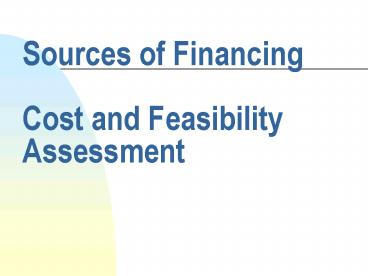Sources of Financing Cost and Feasibility Assessment - PowerPoint PPT Presentation
1 / 13
Title:
Sources of Financing Cost and Feasibility Assessment
Description:
Issues in Raising Capital ... pre-startup advertising and promotion. licenses, permits, taxes ... venture capitalists. Develop a capital structure for your enterprise ... – PowerPoint PPT presentation
Number of Views:20
Avg rating:3.0/5.0
Title: Sources of Financing Cost and Feasibility Assessment
1
Sources of FinancingCost and Feasibility
Assessment
2
Issues in Raising Capital
- Only one source individuals, so personal
relationships with financial sources are
important - Raising money takes time
- Expect to be turned down
- No amount of money will do if you dont know how
to use it
3
Where Do Start-ups get financing?
- Banks 51
- Credit cards 44
- Personal savings 39
- Suppliers 38
- Government 15
- Friends/relatives 12
- None 9
4
Capital StructureKey Questions to Address
- How much capital is needed
- What will the money be used for
- When is the money needed
- How will the money be paid back and when
5
Financial ProjectionsWhy are They Important?
- permits evaluation of businesss feasibility
- brings together the implications of remainder of
business plan - requires an investigation into the financial
aspects of the business
6
What is included?
- A forecast opening balance sheet
- Three years forecast income statements
- Three years forecast balance sheets
- First year monthly cash flow statement
- Two more years of quarterly cash flows or to the
point of positive cash flows
7
Forecast Opening Balance Sheet - Assets
- Estimate all pre-startup expenditures
- land, building and improvements
- equipment and vehicles
- equipment installation
- starting inventory and supplies
- pre-startup advertising and promotion
- licenses, permits, taxes
8
Forecast Opening Balance Sheet (ctd)
- Determine sources of financing
- Personal resources
- banks (term loans)
- development agencies, eg, ACOA
- youth venture funds
- term lenders (BDC, mortgage companies)
- angels
- venture capitalists
- Develop a capital structure for your enterprise
9
Forecast Annual Income Statement
- If possible, use a model statement from a text or
other source as a guide - Determine sales revenues from your market
assessment and market share - Estimate expenses through contact with suppliers
- Complete a forecast income statement
- Consider break-even approach
10
Forecast Monthly Cash Flow Statement
- Begin with Forecast annual income statement
- Assign each revenue and expense to specific
months - Consider credit terms to customers and from
suppliers - Determine when each monthly revenue/expense will
be collected/paid - Complete the statement
11
Benefits of Monthly Cash flow Statement
- Arguably the most important of the forecast
statements - Forces entrepreneur to consider timing of
revenues and expenses - Identifies periods of temporary cash shortages
- Enables entrepreneur to plan working capital
borrowing
12
Forecast Annual Balance Sheet
- Begin with either forecast opening balance sheet
or previous years forecast - Update each item using the forecast income
statements and cash flow statements - Add new items, such as accounts receivable or
payable - Complete forecast balance sheet
13
Sequence of Completion
- Begin with the forecast opening balance sheet
- Next complete the forecast income statement for
year 1 - Complete the forecast cash flow statement for
year 1 - Complete the forecast balance sheet for year 1
- Repeat the latter three steps for years 2 and 3































